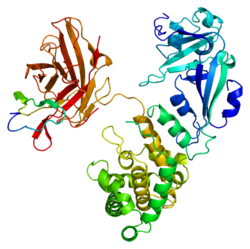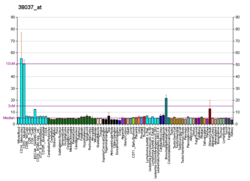Heparin-binding EGF-like growth factor (HB-EGF) is a member of the EGF family of proteins that in humans is encoded by the HBEGF gene.
HB-EGF-like growth factor is synthesized as a membrane-anchored mitogenic and chemotactic glycoprotein. An epidermal growth factor produced by monocytes and macrophages, due to an affinity for heparin is termed HB-EGF. It has been shown to play a role in wound healing, cardiac hypertrophy, and heart development and function.[5] First identified in the conditioned media of human macrophage-like cells, HB-EGF is an 87-amino acid glycoprotein that displays highly regulated gene expression.[6] Ectodomain shedding results in the soluble mature form of HB-EGF, which influences the mitogenicity and chemotactic factors for smooth muscle cells and fibroblasts. The transmembrane form of HB-EGF is the unique receptor for diphtheria toxin and functions in juxtacrine signaling in cells. Both forms of HB-EGF participate in normal physiological processes and in pathological processes including tumor progression and metastasis, organ hyperplasia, and atherosclerotic disease.[7] HB-EGF can bind two locations on cell surfaces: heparan sulfate proteoglycans and EGF-receptors effecting cell-to-cell interactions.[8]
- ^ a b c GRCh38: Ensembl release 89: ENSG00000113070 – Ensembl, May 2017
- ^ a b c GRCm38: Ensembl release 89: ENSMUSG00000024486 – Ensembl, May 2017
- ^ "Human PubMed Reference:". National Center for Biotechnology Information, U.S. National Library of Medicine.
- ^ "Mouse PubMed Reference:". National Center for Biotechnology Information, U.S. National Library of Medicine.
- ^ Nanba D, Higashiyama S (February 2004). "Dual intracellular signaling by proteolytic cleavage of membrane-anchored heparin-binding EGF-like growth factor". Cytokine Growth Factor Rev. 15 (1): 13–9. doi:10.1016/j.cytogfr.2003.10.002. PMID 14746810.
- ^ Jin K, Mao XO, Sun Y, Xie L, Jin L, Nishi E, Klagsbrun M, Greenberg DA (July 2002). "Heparin-binding epidermal growth factor-like growth factor: hypoxia-inducible expression in vitro and stimulation of neurogenesis in vitro and in vivo". J. Neurosci. 22 (13): 5365–73. doi:10.1523/JNEUROSCI.22-13-05365.2002. PMC 6758221. PMID 12097488.
- ^ Raab G, Klagsbrun M (December 1997). "Heparin-binding EGF-like growth factor". Biochim. Biophys. Acta. 1333 (3): F179–99. doi:10.1016/S0304-419X(97)00024-3. PMID 9426203.
- ^ Das SK, Wang XN, Paria BC, Damm D, Abraham JA, Klagsbrun M, Andrews GK, Dey SK (May 1994). "Heparin-binding EGF-like growth factor gene is induced in the mouse uterus temporally by the blastocyst solely at the site of its apposition: a possible ligand for interaction with blastocyst EGF-receptor in implantation". Development. 120 (5): 1071–83. doi:10.1242/dev.120.5.1071. PMID 8026321.






